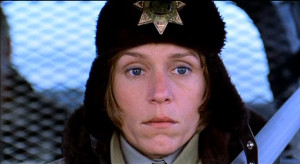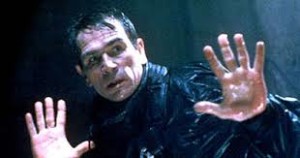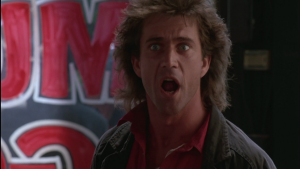Got an email from a writer which asked the following (used by permission):
Dear Mr. Bell,
Ok, so I’m big on stupid questions. I just had a thought as I was musing about my latest book. I know the main character has to change. That’s a big deal. But what about secondary characters? What about the bad guy? Do the secondary characters change, but less? or something… And I want the bad guy to go from neutral to really bad… Does that make sense? Not something I can google…
First off, that’s not a stupid question at all. In fact, it’s a great question with good instincts about the craft. Here are my thoughts on the matter.
The Main Character Can Change in Two Ways
In my book, Write Your Novel From the Middle, I explain that not all MCs have to change from one state of being to another. That kind of arc is, of course, common in fiction.
For example, Ebenezer Scrooge. He starts out as a misanthrope and ends up a generous, compassionate member of the community. Martin Riggs, the suicidal cop in Lethal Weapon, changes from self-destructive loner to close friend of his partner, Roger Murtaugh, and Murtaugh’s whole family.
This type of change comes only through the fire of Act II. A life lesson is learned. Now the MC is a new person with something of value for the community. As my friend Chris Vogler puts it, the hero returns home with an elixir: he has new wisdom and insight to share with his ordinary world.
Of course, as I also note, the MC can change in the opposite direction. Michael Corleone goes from a loyal American soldier to the soul-deadened Godfather of the Corleone family. That’s because in Act II his father is nearly killed by members of another crime family. At the crucial “mirror moment,” Michael realizes he’s the only one of the three brothers who actually knows how to exact revenge. Thus begins his negative slide.
In this type of large-scale change, the MC goes from pole to pole.
But that’s not always how a character changes. There’s another way. That’s when the MC retains the same basic nature, but grows stronger because of the life-and-death challenges of Act II.
An example is Dr. Richard Kimble in The Fugitive. He’s the same decent man at the end as he was at the beginning. But he has had to learn survival skills. He is forced to grow stronger because he was wrongly convicted of murdering his wife. When he escapes from a prison bus, he has to stay alive and out of the law’s reach so he can find the real killer.
Marge Gunderson, of Fargo, is the same decent, small town police woman at the end as at the start. But she has to ramp up her skills to bring a vile murderer and a devious scam artist to justice. This is not like the misdemeanors she’s used to!
So consider what kind of change your MC is going through: change of nature, or growing stronger?
Also consider this: A character can resist change. He can be “offered grace” (Flannery O’Connor’s term) but turn it down. That’s what makes for tragedy.
In Act IV of Othello, Emilia, Desdemona’s attendant (and, unfortunately, the wife of Iago) pleads Desdemona’s innocence to Othello in no uncertain terms. But when she exits, Othello mutters that she is a “subtle whore” and refuses to believe her. He kills his wife instead.
Finally, change can come too late, which is also tragic. Think Scarlett O’Hara in Gone With the Wind.
Secondary Character Change
A powerful trope is the change of secondary characters, brought about by the courage and example of the MC.
 Here is where The Fugitive elevates above most action films. The opposition to Richard Kimble is Sam Gerard, the lawman played by Tommy Lee Jones. He makes it clear early on he has only one job: catch Kimble. When Kimble has a gun on him and insists he’s innocent, Gerard says, “I don’t care!” Because it’s not his job to care. At that point Kimble thinks, “Oh, crap” (my interpretation of Harrison Ford’s facial expression) and so he dives off that spillway and goes kersplash in the waters below.
Here is where The Fugitive elevates above most action films. The opposition to Richard Kimble is Sam Gerard, the lawman played by Tommy Lee Jones. He makes it clear early on he has only one job: catch Kimble. When Kimble has a gun on him and insists he’s innocent, Gerard says, “I don’t care!” Because it’s not his job to care. At that point Kimble thinks, “Oh, crap” (my interpretation of Harrison Ford’s facial expression) and so he dives off that spillway and goes kersplash in the waters below.
But observing this, and other behaviors of Kimble––as well as seeing what a lousy job the Chicago cops did on the original investigation––Gerard does begin to care. Until, at the end, he helps Kimble get the real bad guy.
Another example is Louis, the corrupt French police captain in Casablanca. Watching how Rick gradually begins to take sides against the Nazis, Louis finally finds his conscience at the end, letting Rick off the hook for murdering Major Strasser. To the arriving police force Louis says, “Round up the usual suspects.” Not only that, Louis walks off with Rick to join the war effort. It is “the beginning of a beautiful friendship.”
This kind of change enhances the theme of a story. We like to see things like justice and honor prevail. When they do, it ought to be powerful enough to inspire secondary characters, too.
Bad Guy Going From Neutral to Worse
There is no reason at all you can’t show a villain growing more villainous as the story moves along. You can show this via parallel plotline from the villain’s POV, or you can utilize it as the “shadow story,” which I wrote about here. What happens off screen with the villain? How is he altering his plans, ignoring his conscience, falling further and further from his humanity? Give it some thought and weave that material into the narrative as you see fit.
A plot is about a character who uses strength of will against the forces of death––be they physical, professional, or psychological. No one goes through such a crucible without changing or becoming stronger.
It’s your job to show us the change and make us glad we stuck around for a whole book to see it.
What are some of your favorite examples of character change?


Excellent article! One of my favorite examples of character growth is The Secret Garden. Mary and Colin start out as ill little monsters, but over the course of the story, heal into compassionate human beings. Same with Understood Betsy, who learns that there is such thing as a joke (among other things).
I also love it when characters find out things about themselves and resolve to change, like the amazing plot twist at the end of Archer’s Goon, by Jones. One of the best uses of time travel I’ve ever seen. And speaking of time travel, in Back to the Future, Marty and Doc both change for the better over the course of the movies, because death is on the line if they don’t.
Ah yes, The Secret Garden is wonderful in that way. Thanks, Kessie.
Back to the Future is an all time favorite. Thinking about it, the big change is in George, Marty’s father…all because of Marty’s intervention.
Favorite line: “I’m your density!”
Thanks for a great post, Jim.
I recently decided to read through Kris and Kelly’s (P J Parrish) Louis Kincaid series. I just finished reading DARK OF THE MOON (first in the series). Louis’ character arc was impressive. He looks into the eyes of the artist’s rendition of the victim ( a bust made from an old skull), and decides that he must uncover the truth – even though it will cost him dearly and even though he realizes that justice will never be served. He “owes” it to the victim. Very powerful character arc.
Thanks for answers to a good question.
Right on, Steve. The PJ sisters know the craft, and demonstrate it book after book.
A belated thank you for the kind shout out, Steve.
Jim,
Love this post. I was talking to a friend the other day, saying I believe you can’t have a truly engaging story without the main character dealing with internal conflict and changing/growing in some way. All your examples are great, and I really like to see secondary characters change/grow–Louis in “Casablanca” is a personal favorite.
A few other favorite examples of character change:
In the recent science fiction film, “Live. Die. Repeat: The Edge of Tomorrow,” Major William Cage changes from a cowardly combat shirker interested only in saving his own skin into a brave, determined soldier who has something worth fighting for, in a “Ground Hog Day” like time recursion, reliving the same day, dying myriad times in the process. Each death and subsequent “reset” gives him a little more understanding and push toward becoming a better person dedicated to helping save humanity from an alien menace. (Aside: Cruise’s performance as the cowardly and selfish Major Cage really impressed me, playing against his normal brave and selfless hero roles.)
The Dude in “The Big Lebowski”: he becomes an investigator, solving a very twisted, mystery, able to put the threads together despite his drug fueled brain, reaffirming his life, such as it is. Considering what a world class slacker the Dude is, his becoming even a remotely effective detective is a heroic feat in my book.
In Tana French’s novel “A Faithful Place,” Dublin undercover detective Frank Mackey begins the novel estranged from his family. Solving an old, personal mystery with horrific underpinnings leads to his overcoming his estrangement and a reconciliation of sorts with his family.
For secondary character growth there’s Sam in the “Lord of the Rings,” who overcomes his fear and grows stronger in helping his friend, Frodo, on his long and arduous quest, taking his master’s burden for a time, and becoming a hero in his own right, disguising himself to fool the Orcs and braving many dangers to free his friend from captivity. Sam’s earnest, humble everyman is perhaps my favorite character from the trilogy.
Finally, and no spoilers, crime boss Wilson Fisk in the new Netflix “Daredevil” series is a fantastic example of a man growing into his villainy. I highly recommend that series for the various characters’ arcs.
All great examples, Dale. The Dude abides.
Great stuff, Jim. There’s also a category of MCs that rarely if ever change, thereby leaving the antagonist and secondary characters room for a defined arc. Dirk Pitt, Jason Bourne, Harry Callahan, James Bond, Sherlock Homes, Ripley (Alien franchise), Jack Bauer, Fox Mulder and Dana Scully (X-Files). These characters are basically the same coming out as going in. What you see is what you get. There are instances of increased strength, but by and large they’re already strong enough. They’re level-headed, dependable characters we can count on show after book after movie. If there is such a thing as a plot-driven story, it’s heroes like these that top the cast.
Right, Joe. One can say these types do get a little stronger because each challenge is new, thus adding to their skill set. This kind of series is like popcorn or cotton candy for me. That’s why I prefer a Bosch or even a Mike Hammer as a steady diet (Yes, I said Mike Hammer. Spillane was crafty that way). But every now and then you need to just let go with, oh, a little Mack Bolan, hopefully spiced with at least a little inner conflict.
Best examples I can come up with lead to murder.
Hank Mitchell in, Simple Plan, transforms from a feed store accountant into a murderer in order to keep his ill gotten pile of cash.
The great James Cain’s, Walter, in Double Indemnity, a mild mannered insurance salesman kills for the woman he wants. But after he kills for her, he doesn’t want her anymore. Awkward. As a side note, a great example of stated goal vs. true goal.
‘Cape Fear’ An attorney that relies solely on law and order, the establishment, until his family is threatened then he arms himself and kills the guy and in the context of the story, regains his manhood.
And in my own soon to be queried piece, a corrupted law enforcement officer learns his true goal is redemption, serving the community. This realization comes with a great cost
Great, great example of good to bad arc, Scott Smith’s A Simple Plan. Thanks for reminding me, MG.
I’m glad to see that a character doesn’t have to go through a “personality transplant,” but can indeed grow stronger in who they are or who they will be.
Growing stronger can be just as inspirational as change. We need both kinds of stories!
Wow! This is a great post. Lots of good information to think about and make note of for character arcs. Thanks!
Thank you for stopping by, Angelique.
My complaint is that my first two (unsold) novels were rejected, in part, because the editors didn’t like the way the character started: too wimpy, too much reacting, they said. Oh, they liked the characters fine later, but couldn’t “identify with” the characters the way they started. It did no good to explain that that change, from passive to active hero of his own adventure was the whole point. If the characters started out that way, what would be the point of the story?
The story arc is *about” the change. Without it, the “arc” is a flat line, and in a hospital, we know what a flat line means, right?
I’m still convinced I was right about the stories. There may be problems, but it’s not the character’s growth. So I’m preparing to embark on the “exciting” (read that, “scary”) seas of self-publishing. I know I have an audience for the books. I’ve got too much time and energy invested in them to write them off.
I’m ready to take a gamble on myself.
John, it’s okay for a character to start as a “wimp,” so long as you show in the very first chapter a capacity for change–some nascent “strength of will” which gives the reader hope for a transformation. We will root for a character so long as he doesn’t only react.
Thanks. I thought i did that, but I’ll definitely be on the lookout when I start my pre-pub rewrite Monday.
Oh, Eustace Scrubb in “Voyage of the Dawn Treader.” A contemptible kid who grows into a hero. For that matter, Edward in “The Lion, the Witch and the Wardrobe,” and Lucy in “Prince Caspian.” And my favorite of the Narnia series, “The House and His Boy,” where every character goes through a transformation into his or her better self.
Horse and His Boy. House? Where did THAT come from? Damn autocorrect.
Excellent analysis, Jim. And so clearly stated. I love how you choose examples from books and movies most of us are familiar with, for immediate comprehension. Thanks for this!
I love movie examples, because they are known and easily analyzed.
I think the Narnia series is a great showcase for those kinds of character transformations. Thanks for another great post Jim. I certainly believe that even secondary characters need to go on a journey through the book/series as well as the main protagonists.
Journeys. That’s a good, simple way to talk about fiction.
At the rkak of coming off like a brown-noser~,:-). I like how Ty Buchannan “morphs” from big corporate lawyer to advocate for the down amd downtrodden with/for the good siaters.
Hey, I appreciate that so much! Ty’s journey is three books long, and I think I got to just the right spot at the end.
Hi, James Scott Bell! I was thinking about character change just his morning. I love the examples of Michael Corleone and Marge Gunderson. I was thinking about Ed, the MC of James Dickey’s Deliverance (book is so incredibly well-written but made notorious by a particular scene in the movie). Ed is made stronger by a near-death experience. But since he was a good guy in the beginning of the story, he didn’t have much changing to do.
Thanks for the tip on Twitter that interesting conversations were happening on this blog submission.
Jeff
Thanks for the visit, Jeff. Drop by anytime!
Another timely post. It has me thinking now how to develop the arc to my villain in my sequel. The movie references gave a great visual for the concept of the character changes.
Thanks for always giving me food for thought!
Food is what we’re here for, Julie. Thanks for stopping by.
Hey Jim. Probably my favorite recent article!
Thanks because you showed me the brilliant bizarro character arc of Michael Corleone. Now I need to go study and search for more (bizarro) character arcs similar to his.
Thanks so much!
Michael is a great character study.
It’s been ages since I’ve seen it, but I wonder if the original Scarface (1932) has a similar arc.
Pingback: A Month in Blogs – April 2015. | Debbie Johansson